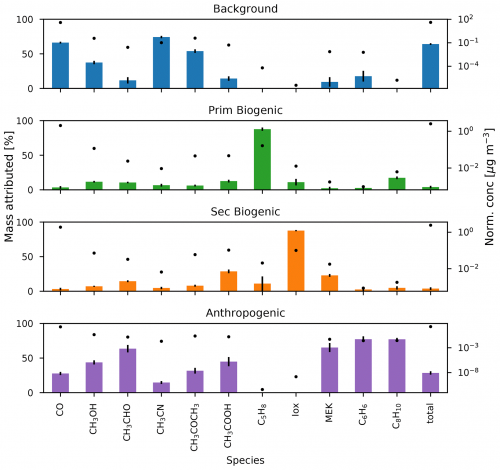Scientific context
During the 2017-2019 OCTAVE project, the Royal Belgian Institute for Space Aeronomy deployed a high-resolution Proton–Transfer-Reaction Mass Spectrometry (PTR-MS) instrument at the high altitude Maïdo observatory located on La Réunion, an island in the remote southwestern Indian Ocean.
With the PTR-MS instrument, a near-continuous 2-year dataset of concentrations from a selection of volatile organic compounds was obtained. This data is of high value due to the scarcity of this type of measurements available in the southern hemisphere and specifically in remote locations.
Measurement site
La Réunion is a small volcanic island located in the southwestern Indian Ocean. It is isolated from large bodies of landmass with Madagascar being the closest at about 700 km west of La Réunion. Although it is small in size, the height profile is complex with the Maïdo observatory being located at 2150 m above sea level, near the top of the Maïdo mountain slope.
The observatory is surrounded by a large national park. Due to its location, it is generally located in the free troposphere during the night. During the day, however, it is generally located near a front that moves along the Maïdo mountain slope and separates air coming from the East versus air originating west of the observatory. During the daytime, air masses are originating from the remote marine background but enriched by emissions from local sources.
Sources affecting the dataset
From the initial analysis, it was found that 4 sources contributed significantly to the presence of the reactive trace gases observed.
- The most important source was identified to be human activity (38% of VOC mass over the total campaign).
- The second source with significant contributions over the two year period was found to be a combination of atmospheric background and biomass burning plumes (33% of VOC mass). Especially in the period from August to November, biomass burning plumes originating from southern Africa and Madagascar affect the atmosphere significantly at Maïdo.
- The last two identified sources were related to terrestrial ecosystems (29 % of VOC mass). This result was remarkable as the Maïdo observatory is surrounded by a large natural park populated with native ecosystems, while human activities are centered near the coastal areas further away.
Reference:
Verreyken, B., Amelynck, C., Schoon, N., Müller, J.-F., Brioude, J., Kumps, N., Hermans, C., Metzger, J.-M., Colomb, A., and Stavrakou, T.: Measurement report: Source apportionment of volatile organic compounds at the remote high-altitude Maïdo observatory, Atmos. Chem. Phys., 21, 12965–12988, https://doi.org/10.5194/acp-21-12965-2021, 2021.

